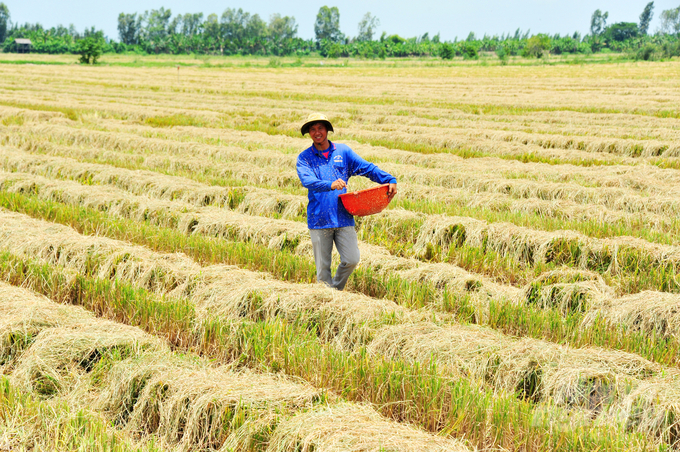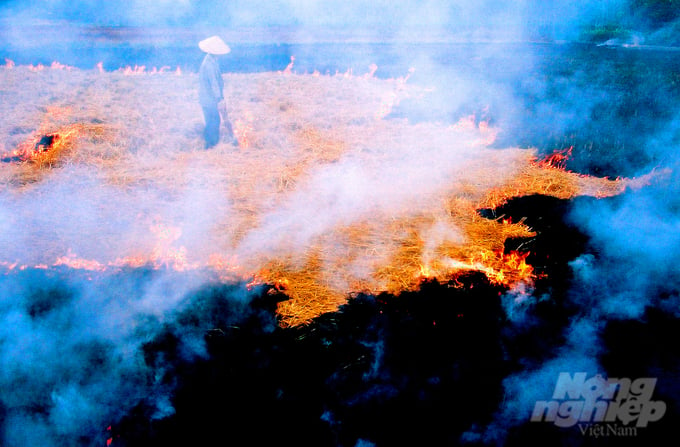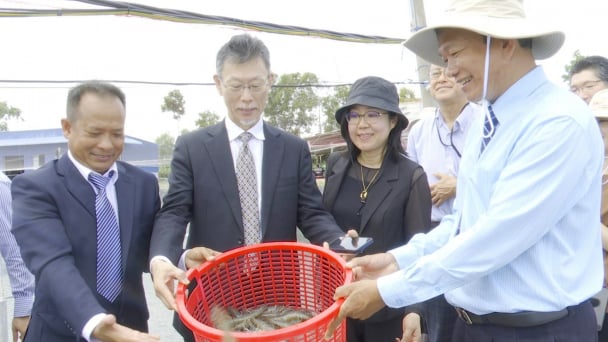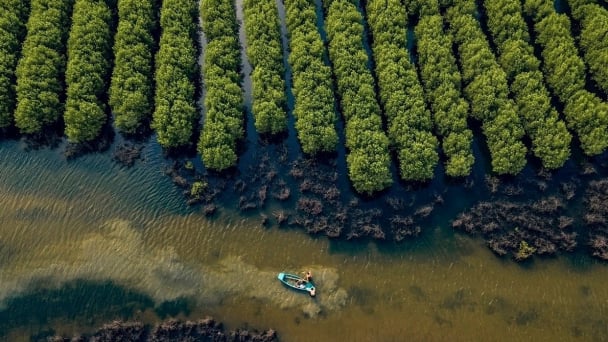June 15, 2025 | 07:21 GMT +7
June 15, 2025 | 07:21 GMT +7
Hotline: 0913.378.918
June 15, 2025 | 07:21 GMT +7
Hotline: 0913.378.918

After each harvest, farmers leave a significant amount of rice straw on the fields. Photo: Le Hoang Vu.
Dong Thap is regarded as one of the key rice-producing provinces in the Mekong Delta region. However, during the production process, farmers rely on the practice of rice straw burning after each harvest to clear the fields. Farmers are generally unaware of the numerous negative impacts their practice poses on the environment and human health.
Notably, local farmers leave a significant amount of rice straw on the fields after harvesting every year. To quickly clean the fields and reduce costs, farmers often elect to burn the straw directly on the field. Tran Van Hung, a farmer in Lap Vo District, commented that rice straw burning is a quick and simple solution that allows farmers to save labor and eliminates the need to hire workers to collect the straw. Without burning, farmers may face difficulty in preparing the soil for the next crop due to the large volume of straw.
Conversely, the practice of rice straw burning also causes numerous adverse effects. In addition to causing air pollution and negatively impacting human health, this practice degrades the soil, reducing its fertility and depleting valuable nutrients present in the straw.
The burning of rice straw releases a considerable amount of CO2 and greenhouse gases, which further exacerbates climate change issues. Moreover, the smoke and dust from burning straw obstruct traffic and directly affect the respiratory health of nearby residents.
According to Nguyen Van Hong, Head of the Department of Agriculture and Rural Development in Tam Nong District, rice straw burning is a difficult habit for many farmers to abandon. Despite efforts by local authorities to raise awareness regarding the harmful effects of straw burning, farmers continue this practice because it is convenient and time-saving. The local agricultural sector is making an active effort to encourage farmers to adopt more sustainable practices and transition towards circular organic production methods.

The burning of rice straw releases a significant amount of CO2 and greenhouse gases, which further exacerbates climate change. Photo: Le Hoang Vu.
Nguyen Van Vu Minh, General Director of Dong Thap Province's Department of Agriculture and Rural Development, highlighted that the practice of rice straw burning harms the environment and depletes the organic matter that can be reused to improve soil fertility. With the aim of addressing this challenge, the province has implemented various measures to assist farmers in managing rice straw after harvest in an environmentally friendly manner.
In response to increasingly severe climate change issues and the need for sustainable development, Dong Thap Province has actively promoted agricultural restructuring programs aimed at transitioning rice production towards green and sustainable practices. A notable key initiative is the "Sustainable Development Project for one million hectares of specialized, low-emission high-quality rice in association with green growth in the Mekong Delta region by 2030."
Under this project, Dong Thap aims to establish a high-quality rice production area with the aim of meeting domestic market demand and enhancing export value. Additionally, reducing greenhouse gas emissions, improving the agricultural production environment, and adopting environmentally friendly farming practices remain central objectives for the province.

The agricultural sector in Dong Thap Province is encouraging farmers to utilize rice straw for organic fertilizer production or to apply new technologies that transform straw into by-products such as animal feed or biodegradable materials. Photo: Le Hoang Vu.
"The practice of rice straw burning directly contrasts with the objectives of the project. We are promoting the use of rice straw for organic fertilizer production as well as the adoption of new technologies to convert straw into by-products such as animal feed or biodegradable materials. This project helps reduce environmental pollution and provide additional economic value for farmers," stated General Director Nguyen Van Vu Minh.
Nguyen Van Hung, Director of the Thang Loi Agricultural Service Cooperative, reported that 20 farming households in the cooperative are participating in the high-quality rice project, with a total rice production area spanning 43 hectares for the summer-autumn crop. Accordingly, farmers have adopted mechanization in sowing (using row planting and clumping methods in combination with fertilizer application), which has reduced seed usage by 80 kilograms per hectare compared to machine spraying (70 kilograms of seed per hectare). In addition, farmers decreased fertilizer application by 20 to 40%, minimized pesticide spraying and collected straw from the fields. Notably, the local business community has established contracts and agreements to purchase the local rice yield.
As a result, farmers have lowered production costs, enhanced the quality of the rice grains, increased profits, and reduced environmental pollution, with a decrease of 4.92 tons of CO2 equivalent per hectare in greenhouse gas emissions. Rice yield ranges from 6.5 to 6.9 tons per hectare. Local businesses have also agreed to purchase the entirety of the yield at prices higher than the market by 100 to 150 VND per kilogram. The profit from this model is 2.2 million VND per hectare higher compared to traditional farming practices.
Notably, additional income from selling straw after harvest ranges from 800,000 to 900,000 VND per hectare compared to traditional practices.
Translated by Nguyen Hai Long
![Turning wind and rain into action: [4] Bringing climate bulletins to remote and isolated areas](https://t.ex-cdn.com/nongnghiepmoitruong.vn/608w/files/linhnhp/2025/06/14/1152-z6704423696987_15fd32ffc26d590d204d520c9dac6786-nongnghiep-151141.jpg)
(VAN) The Vietnam Agriculture and Nature Newspaper interviewed Mr. Vu Thai Truong, Acting Head of Climate Change and Environment at UNDP Vietnam, to gain deeper insight into how climate bulletins are delivered to farmers.

(VAN) In Tien Giang, a high-tech shrimp farm has developed a distinctive energy-saving farming model that has yielded promising results.
![Turning wind and rain into action: [3] 300.000 farmers benefit from agro-climatic bulletins](https://t.ex-cdn.com/nongnghiepmoitruong.vn/608w/files/news/2025/06/12/e5a48259d6a262fc3bb3-nongnghiep-125122.jpg)
(VAN) The agro-climatic bulletin has become a valuable tool for farmers in the Mekong Delta. After more than five years of implementation, the initiative is gradually being expanded nationwide.
![Turning wind and rain into action: [2] Providing forecasts to the people](https://t.ex-cdn.com/nongnghiepmoitruong.vn/608w/files/news/2025/06/12/e5a48259d6a262fc3bb3-nongnghiep-103927.jpg)
(VAN) In addition to improving the quality of hydrometeorological forecasts, putting forecast bulletins into practical use is crucial for production and disaster prevention.

(VAN) Blue carbon is receiving attention for its rapid absorption capacity and vast potential. It represents a promising nature-based solution to respond to climate change.
/2025/06/11/3507-1-161904_583.jpg)
(VAN) Seagrass beds and coral reefs serve as 'cradles' that nurture life in the ocean depths, creating rich aquatic resources in Vietnamese waters.
![Turning wind and rain into action: [1] Forecasting for farmers](https://t.ex-cdn.com/nongnghiepmoitruong.vn/608w/files/news/2025/06/11/e5a48259d6a262fc3bb3-nongnghiep-111919.jpg)
(VAN) Weather is no longer just a matter of fate. Forecasts have now become an essential companion for farmers in every crop season.